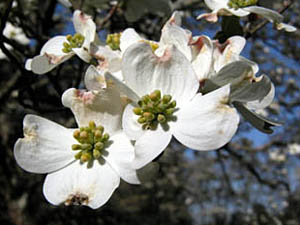By Wren Smith
 What is your favorite native flowering tree? If you said flowering dogwood, you aren’t alone. Flowering dogwoods, Cornus florida are favored by many people, as well as wildlife – providing beauty and ecological value to our landscapes. Flowering dogwood trees owe their showy beauty to special modified leaves known as bracts. These large white bracts surround the button-sized cluster of true flowers in the center. Usually blossoming while redbuds, Cercis canadensis, are still in bloom, the glowing white of the dogwoods against the vibrant green of spring foliage is stunning. But the beauty of these dogwoods go beyond the surface. According to the USDA, the red berries of flowering dogwood are eaten by over 36 species of birds, and numerous mammals such as chipmunk, foxes, and opossums. Rabbits and deer nibble the bark, twigs, and leaves.
What is your favorite native flowering tree? If you said flowering dogwood, you aren’t alone. Flowering dogwoods, Cornus florida are favored by many people, as well as wildlife – providing beauty and ecological value to our landscapes. Flowering dogwood trees owe their showy beauty to special modified leaves known as bracts. These large white bracts surround the button-sized cluster of true flowers in the center. Usually blossoming while redbuds, Cercis canadensis, are still in bloom, the glowing white of the dogwoods against the vibrant green of spring foliage is stunning. But the beauty of these dogwoods go beyond the surface. According to the USDA, the red berries of flowering dogwood are eaten by over 36 species of birds, and numerous mammals such as chipmunk, foxes, and opossums. Rabbits and deer nibble the bark, twigs, and leaves.
While it may be possible to witness these larger species feeding on the berries, sometimes it’s the hidden gifts that keep on giving. In the case of dogwood trees, it’s their role in the calcium cycle that I find fascinating. Dogwood trees have a unique ability to extract or ‘mine’ calcium from the soil and concentrated it in their leaves. When animals eat these leaves, they “borrow” this calcium by using it to strengthen their bones and teeth. When those animals die the calcium is returned to the soil. Uneaten leaves, rich in calcium, fall to the forest floor in autumn and decay; as they do, small invertebrates such as land snails feed on them. Eventually the calcium returns to the soil in a continuous cycle of giving.
Flowering dogwoods are threatened by the anthracnose fungus, Discula destructiva, that is devastating trees in parts of their range. Don’t take these important native trees for granted; flowering dogwoods deserve our admiration and our protection.
Want more Vanishing Acts? Click here to view the archive.
Vanishing Acts: Trees Under Threat was developed and produced by The Morton Arboretum in association with the Global Trees Campaign, a partnership between Fauna and Flora International and Botanic Gardens Conservation International.
Funding for this exhibit comes from The Morton Arboretum and the U.S. Institute for Museum and Library Services, Museums for America Grant Program.
Support locally comes from LG&E and KU. Additional support provided by Shepherdsville/Bullitt County Tourism.

